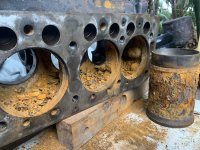- Joined
- Aug 2, 2000
- Messages
- 11,457
To hone them for a start, they may move when the honer is operated. Also to replace the liner seals.It's pretty much what Greenpeace said above with two bolts at opposite ends of a diameter. I would also believe this is right. You can apply a huge amount of force to pull straight up or you can rock it side to side with Greenpeace's method incrementally until the rust or whatever bonds break and then it doesn't take much force to pull it out.
I would also suggest some freeze and release might be of help. I managed to get some really stubborn headbolts broken in the block to move that way.
Why pull out the sleeves anyway? I mean if they are to be replaced one doesn't need to take any care in extracting them, which opens a lot of other options. If they are to be reused, why take them out in the first place?

